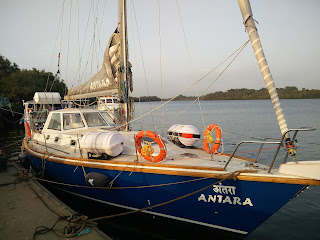Learning the Ropes
 |
| First test rig |
Meanwhile. one of the first things we did on getting Antara out of the shed, was to put up her mast and boom. They can't stay up on their own, so the forestay and the backstay were put up too. That's when we realised that the forestay was a little short. With a sailboat such things are expected and I'm learning to not expect a perfect fit the first time.
Tied up in knots
We used one of the halyards then and moved on to the other ropes. We started with the mainsail sheets. These will help move the mainsail from side to side and will be controlled from the cockpit. As we laid out the rope, we had to keep in mind the rope width (12mm), the fittings required and the appropriate length such that it would be long enough for a boom stretched out on a broad reach. Then we set up the furler line and the foresail sheets. The latter had to go through the cars (guiding wheels, sort of) attached to a track laid out on the deck. The cars have to be placed accurately on the track and the other fittings placed accordingly. That done, we put up the runners. That's when we ran out of fittings.
 |
| Second test rig |
Around the same time we realised that to register the boat to sail anywhere in the world, we needed a lot of SOLAS compliant equipment. One of them being liferafts. Usually one can get valise sized liferafts, compact, easy to handle and to place anywhere on the boat. The regulation liferaft, however, is a monstrosity, and needed special accommodation. Johan came to our rescue again with a niftily designed roll bar. But this meant splitting the backstay. Well the good news was, the backstay could now be used as a forestay and the current backstay could be shortened to fit in a forked extension.
So we have ended up ordering some of the equipment and creating the rest. Our first test rig was on October 29th; the second, was on January 24, 2019. Antara was now afloat in the River Mhadei. After a hiatus of more than a year I was back on a boat, in the water, and I was pleasantly surprised to see how quickly I felt at home. We redid the rigging and the fittings and then went one step further. This time, we screwed on the fittings with nuts and bolts. So now our shackles and blocks and padeyes and stoppers are all in place.
All we need now are the appropriate ropes for the tricing lines and the lazy jacks.
Fender bender
 |
| Check that monogrram fender |
That done, we looked around and the first thing that caught our eye was the lack of fenders to protect Antara from the occasional brush with a neighbouring boat. So fenders were promptly ordered, cloth bought, covers stitched and monogrammed and put up within a week!
 |
| Spliced rope on a fender |
This is when I learnt to splice a rope. Spliced ropes are a better way to create strong loops to hang stuff including fenders. I had seen Trevor, my Clipper First Mate do it using a fancy rope cutting gizmo and fids to separate the rope strands. Dilip and I used a cutter, a lighter and a pencil, to splice ropes for the fenders, and I for one, am proud of the result.
It was sobering therefore to see Sachin casually splice a rope the next day when fixing the anchor cable.
With Antara you now have the opportunity to sail, safe in Covid times - on a large sailboat, along the coast, in the deep blue yonder! You decide and we'll design a sail just for you.




Comments
Post a Comment